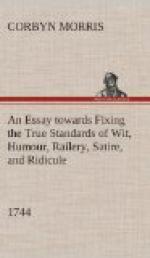Ambiguity of their Sense, or the Affinity of their
Sound: Sometimes it is wrapp’d in a Dress
of humorous Expression: Sometimes it lurketh
under an odd Similitude: Sometimes it is lodged
in a sly Question, in a smart Answer, in a quirkish
Reason, in a shrewd Intimation, in cunningly diverting,
or cleverly retorting an Objection: Sometimes
it is couched in a bold Scheme of Speech, in a tart
Irony, in a lusty Hyperbole, in a startling Metaphor,
in a plausible Reconciling of Contradictions, or
in acute Nonsense; Sometimes a scenical Representation
of Persons or Things, a counterfeit Speech, a mimical
Look or Gesture passeth for it. Sometimes an affected
Simplicity, sometimes a presumptuous Bluntness giveth
it Being. Sometimes it riseth from a lucky
Hitting upon what is Strange; sometimes from a crafty
wresting obvious Matter to the Purpose. Often
it’ consisteth in one knows not what, and springeth
up one can hardly tell how. Its ways are unaccountable,
and inexplicable, being answerable to the numberless
Rovings of Fancy, and Windings of Language.
It is, in short, a Manner of Speaking out of the
simple and plain Way (such as Reason teacheth, and
proveth Things by) which by a pretty, surprizing Uncouthness
in Conceit or Expression, doth affect and amuse the
Fancy, stirring in it some Wonder, and breeding some
Delight thereto. It raiseth Admiration, as
signifying a nimble Sagacity of Apprehension, a
special Felicity of Invention, a Vivacity of Spirit,
and Reach of Wit, more than vulgar; it seeming to argue
a rare Quickness of Parts, that one can fetch in
remote Conceits applicable; a notable Skill that
he can dextrously accommodate them to the Purpose
before him; together with a lively Briskness of
Humour, not apt to damp those Sportful Flashes of Imagination.
(Whence in Aristotle such Persons are termed
“epidexioi”, dexterous Men, and “eutropoi”,
Men of facile or versatile Manners, who can easily
turn themselves to all Things, or turn all Things
to themselves.) It also procureth Delight, by gratifying
Curiosity with its Rareness, or Semblance of Difficulty.
(As Monsters, not for their Beauty, but their Rarity;
as juggling Tricks, not for their Use, but their Abstruseness,
are beheld with Pleasure;) by diverting the Mind from
its Road of serious Thoughts, by instilling Gaiety,
and Airiness of Spirit; by provoking to such Disposition
of Spirit in Way of Emulation, or Complaisance;
and by seasoning Matters otherwise distasteful or
insipid, with an unusual and thence grateful Tange.
This Description, it is easy to perceive, must have cost the Author of it a great deal of Labour. It is a very full Specimen of that Talent of entirely exhausting a Subject, for which Dr. Barrow was remarkable; and if the Point was, to exhibit all the various Forms and Appearances, not of WIT only, but of Raillery, Satire, Sarcasms, and of every Kind of Poignancy and Pleasantry




